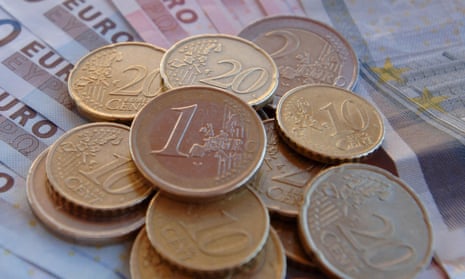Small copper change is on its way out in much of Europe, with Ireland the latest country to drop one and two cent coins from circulation.
From the end of October, retailers will round up or down to the nearest five cent as smaller coins are phased out.
The country joins six other EU nations which have already adopted a rounding policy, including Belgium, Denmark, the Netherlands and Sweden.
The Central Bank of Ireland said one-cent coins, worth about 0.7p, cost more to mint than their equivalent face value: a one cent coin costs 1.65 cents to produce, while the two cent coin costs 1.94 cents.
The phasing out of the one and two cent coins means that the five cent coin – worth 3.7p – will be Ireland’s smallest unit of exchange.
Shops and supermarkets will still be able to price goods at 99 cents or €1.99, for example, but will only give cash change to the nearest five cents. The rounding will only apply to cash transactions, with electronic payments still accepted in one cent increments.
The phasing out of the coins follows a trial in Wexford in 2013, which showed that 85% of consumers and 100% of retailers were happy with rounding.
Charities are worried that the withdrawal of small coins will hit donations. Ireland’s Change for Charity group campaigned to keep small coins. It has 3,000 collection receptacles in schools, shops and banks across Ireland, and said that scrapping the coins could lead to the charity sector missing out on millions in revenue.
But Ronnie O’Toole of the Central Bank of Ireland said evidence showed that consumers and retailers would welcome the move.
“As a country we are good at making changes like this,” he said. “We migrated to the euro ahead of most other countries, and the indications so far are that consumers and retailers alike will embrace rounding.”
The bank said that one cent and two cent coins will remain legal tender, so stashes in piggy banks and old whisky bottles can still be exchanged at banks. It will not be compulsory for retailers to round up or down, but shops will be encouraged to participate, with stickers on tills and posters in shops informing customers of the change.
“The Irish Central Bank will continue to ensure that there is a sufficient supply of one cent and two cent coins – they will still be legal tender,” a spokesman said. “There already exists a lot in circulation, though this stock is largely hoarded in jam-jars and elsewhere in people’s homes. Ireland has produced 2.5bn one cent and two cent coins since the introduction of the euro, enough to go around the island of Ireland seven times, or stacked on top of each other 4,000kms into space. Like many small denomination coins the world over, they cost on average more to mint than their face value, a cost ultimately borne by the taxpayer.”
The Bank of England said there were no plans to withdraw 1p or 2p coins in the UK, although it said any decision would be the responsibility of the Treasury.
The Royal Mint said that in the UK, apart from the introduction of a new £1 coin planned for 2017, there are no current plans to change any other existing UK circulating coin denomination.
Despite talk of a “cashless society”, it said demand for cash has been relatively robust over the past five years, and that the volume of coins in circulation is increasing. There are now 11.3bn 1p coins in circulation, with another 464m pieces minted in the past financial year alone.

Comments (…)
Sign in or create your Guardian account to join the discussion